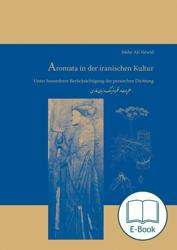This volume is the result of more than 10 years' research in Persian culture from the Achaemenid period (559 B.C.) until the end of the Safavids’ time (1722 A.D.). The main concern was finding out what the sources tell us about aromata (fragrances), how the fragrances were used in daily life and how they are reflected in Persian literature, especially in poetic language.
This study has been undertaken to show how fragrances are referred to in Persian literature and what part they played in Persian art and archaeology. Arabian, Greek and Indian source material as well as secondary literature have been consulted. This to-date quite unique monography deals with the aromatas’ composition, their countries of origin, but also with their diverse metaphoric handling in poetry and with their role in religious ceremonies, weddings, general writing, culinary art, building industry, and habits of giving presents.
Geographically this study focuses on the Iranian culture area which far exceeded today’s Iranian national territory in the times of the Achaemenides, Parthians and Sassanides, so much so that in part it even included Afghanistan, Tajikistan, Uzbekistan, Turkmenistan, Pakistan and even parts of India.
The period considered here beginns with rule of the Achaemenides (550-33 BC) and ends with the Safawid period (1501-1722 AD). In respect to customs and traditions there is little change to be seen in this period, except for the Mongolian era. In particular The Sasanians (224-642 AD), who viwed themselves as the Achaemenides’ successors, were concerned with the preservation of the handed down way of life. Their cultural heritage was taken up by the Abbasides (750-1258), Samanides (892-999), Buyides (945-1055), Ghaznavids (962-1040) and Seljuks (1000-1218).That is why – amongst other traditions - the continuous use of aromas at enthronement ceremonies, receptions, as well as celebrations of Nowruz and Mehregan survived at least until the Seljuks period.
The study consists of 4 parts:
Part I: Aromata of animal provenance (ambergris, castor, musk, zibet)
Part II: Aromata of vegetable matter (aloe wood, camphor, costus, nard, rose water, saffron, sandalwood)
Part III: Mixed fragrances (ointments, pastilles, powders)
Part IV: Aromatic resins, balsams, oils and mannas
„Nun will aber Newids Buch weder die Chemie der heutigen Parfümeure beschreiben, noch ihnen Rezepte liefern. Sein Buch ist vielmehr das Ergebnis einer minutiösen Fahndung nach literarischen Quellen in der persischen Literatur, wo die Herkunft, Anwendung und metaphorische Verwendung der Aromata aufleuchten.
(...) „Der Newid” ist primär als Lexikon nutzbar. Doch führt das Buch den Leser bei fortgesetzter Lektüre ebenso lebendig durch die zweitausendjährige Geschichte und viele Besonderheiten des iranischen Kulturkreises. Die Zitate aus hunderten literarischen Quellen beginnen im Großreich der Achämeniden (550-350 v.Chr.) und enden bei den Safawiden (ca. 1501-1722). (...)
Erwähnt sei noch, dass eine wissenschaftliche Untersuchung hohen qualitativen Ansprüchen genügen muss, um in die Reihe Iran - Turan aufgenommen zu werden. (...) Das bedeutet allerdings nicht, dass das Buch sich lediglich an ein Fachpublikum richtet, auch der interessierte Laie wird es mit Gewinn und Genuss lesen - und vielleicht ist es sogar für die ‘Nasen’ interessant!“
In:
http://www.freunde-islamischer-kunst.de/2010/08/aromata-in-der-persischen-kultur-unter-besonderer-berucksichtigung-der-persischen-literatur/(29.09.2010)
Dr. Mehr Ali Newid has a degree in Archaeology and Philology, with a minor in Byzantine Studies and History of Art from Aristotle University / Thessaloniki. He went on for his post-graduate degree in Indology and Iranian Studies at Ludwig-Maximilians-University / Munich. He has studied Classical and Modern Greek, Sanskrit, Pali and Prakrit, Classical Arabian, Old Persian, Avestan and Pahlavi. His primary scientific interest, besides the three variants of New Persian: Farsi, Dari and Tojiki, lies with the dialects Mazandarani, Khorasani, Kermani, Sistani (Zaboli), Herati, Hazaragi and Kaboli. He is fluent in Pashto and Balouchi. After receiving his doctorate, he taught and researched for many years at the Institute for Indology and Iranistics of the Munich University. He was also employed by the State Collections of Antiques and the State Museum for Ethnology, for whom he prepared several exhibitions, among others the exhibition on "The Art of Buddhism along the Silk Road". At the Institute for History and Culture of the Near East at LMU, his research focuses on new Iranian philology and Islamic History and culture. He has been on numerous field trips to Iran, Uzbekistan, Turkmenistan, Syria, Greece and Turkey. He has published several works on the culture and history of Persia and Afghanistan, most recently „Der schiitische Islam in Bildern – Rituale und Heilige“, München 2006; „Persisches Lesebuch“ (together with Peter-Arnold Mumm), Wiesbaden 2007. A Pashto-German-English dictionary is under way.


 Table of Contents
Table of Contents